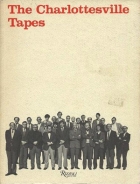 The Charlottesville Tapes is well worth a second read. In 1983, Jaquelin T. Robertson, then architecture dean at the University of Virginia, brought together two dozen architects to a private two-day confab (pointedly, no critics or historians were invited, only practitioners). It was a heavyweight group, a mixture of American, European, and Japanese architects, among them nine future Pritzker Prize winners, and four future Driehaus laureates. Each participant presented one project; discussion followed. The book is an edited version of the conversations. Reading the lively exchanges, one can only reflect on how much has changed since. Several of the participants (Philip Johnson, Paul Rudolph, Charles Gwathmey, O. M. Ungers, Carlo Aymonino) are deceased. Some reputations have risen (Toyo Ito, Tadao Ando), some have not (Kevin Roche, Cesar Pelli). Some of the tyros, like Rem Koolhaas and Robert A. M. Stern, have become household names. Stern presented a Jeffersonian dining hall at UVA—few would have guessed its traditional style would herald a comeback of classicism. Thirty years ago, postmodernism was in full bloom with Michael Graves the man of the hour. Not all the participants at the conference were as well-known: Frank Gehry was still building houses, and Léon Krier wasn’t building anything at all. Much of the discussion centered on urban design. On this point, Robertson was not sanguine: “I have real doubts that the kind of media-hyped, consumer-oriented pluralism that we have today will in fact produce an elegant or an equitable urban environment,” he wrote. Perhaps that was too bleak. The new urbanist movement had yet to appear, and Battery Park City, Celebration, and Poundbury were in the cards. So were iconic buildings such as the Bilbao Guggenheim and the Seattle Public Library, which would influence city development. But Robertson was right: as city building in China and the Gulf would conclusively show, good urbanism remains contemporary architecture’s Achilles heel.
The Charlottesville Tapes is well worth a second read. In 1983, Jaquelin T. Robertson, then architecture dean at the University of Virginia, brought together two dozen architects to a private two-day confab (pointedly, no critics or historians were invited, only practitioners). It was a heavyweight group, a mixture of American, European, and Japanese architects, among them nine future Pritzker Prize winners, and four future Driehaus laureates. Each participant presented one project; discussion followed. The book is an edited version of the conversations. Reading the lively exchanges, one can only reflect on how much has changed since. Several of the participants (Philip Johnson, Paul Rudolph, Charles Gwathmey, O. M. Ungers, Carlo Aymonino) are deceased. Some reputations have risen (Toyo Ito, Tadao Ando), some have not (Kevin Roche, Cesar Pelli). Some of the tyros, like Rem Koolhaas and Robert A. M. Stern, have become household names. Stern presented a Jeffersonian dining hall at UVA—few would have guessed its traditional style would herald a comeback of classicism. Thirty years ago, postmodernism was in full bloom with Michael Graves the man of the hour. Not all the participants at the conference were as well-known: Frank Gehry was still building houses, and Léon Krier wasn’t building anything at all. Much of the discussion centered on urban design. On this point, Robertson was not sanguine: “I have real doubts that the kind of media-hyped, consumer-oriented pluralism that we have today will in fact produce an elegant or an equitable urban environment,” he wrote. Perhaps that was too bleak. The new urbanist movement had yet to appear, and Battery Park City, Celebration, and Poundbury were in the cards. So were iconic buildings such as the Bilbao Guggenheim and the Seattle Public Library, which would influence city development. But Robertson was right: as city building in China and the Gulf would conclusively show, good urbanism remains contemporary architecture’s Achilles heel.
On Culture and Architecture

Years ago I picked up “The Chicago Tapes” (Rizzoli, 1987), but I didn’t realize it was part of a larger series, as seeing this now makes me think. Any idea if there other “Tapes”?
This sounds–and looks–like a knock-off. I have never heard of others.
Didn’t realize you had replied to my comment, so I’m just now seeing it after coming back here while flipping through The Chicago Tapes once again. In fact the book isn’t a knock-off; it’s the record of a second conference, organized by Stanley Tigerman and held in Chicago in 1986, where many of the same figures were present, such as Roberton, Krier, Gehry, Ando, Koolhaas, Pelli, and Rudolph. The copyright page actually says: “A companion to The Charlottesville Tapes, published by Rizzoli in 1985,” and Tigerman’s intro mentions that Rizzoli “agreed to publish the proceedings as the second in an emerging series.” Looks like it never went beyond number two, which is a shame because I like the format and the open conversation between the architects in attendance.
A third volume appeared from Rizzoli in 2002, “The Seaside Debates: A Critique of New Urbanism.” Not sure if it was formally part of a series, but the publisher and book format are the same, and it was conceived as a tribute to Jaquelin Robertson’s “The Charlottesville Tapes.”
It included essays introducing New Urbanism, along with “A New Version of Urbanism” by Robertson and an “Against” essay by Alex Krieger, but largely presentations and critiques of projects from Dover, Kohl; Urban Design Associates (Gindroz); Doug Kelbaugh; Moule and Polyzoides; Cooper Robertson & Assoc. (Shea), Duany Plater-Zyberk and Dan Solomon. Commentators included Colin Rowe, Allan Jacobs, Donlyn Lyndon and Witold Rybczynski.